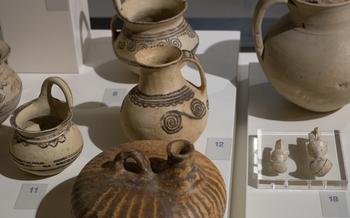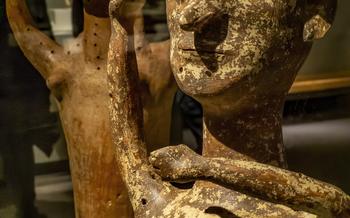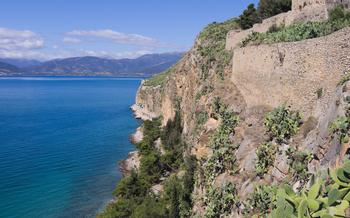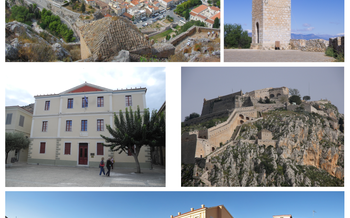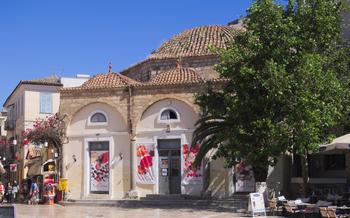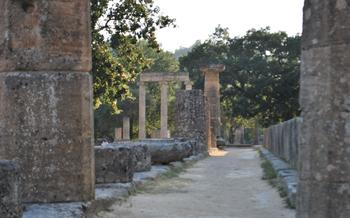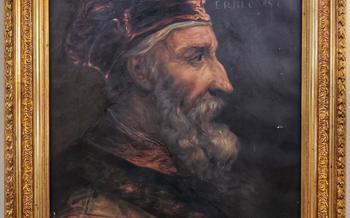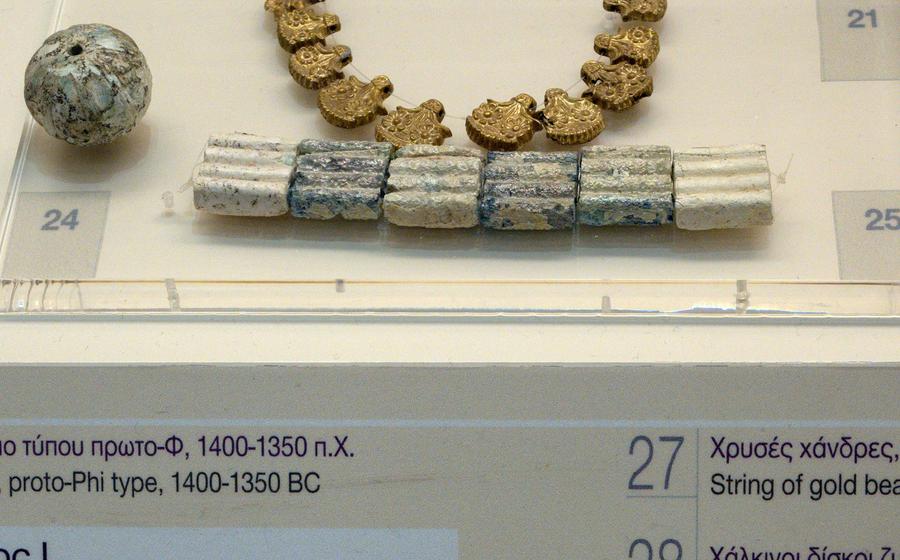
The Archaeological Museum of Mycenae
- History of the Archaeological Museum of Mycenae
- Location and Getting There
- Admission and Hours of Operation
- Museum Layout and Highlights
- The Gold of Mycenae
- The Funerary Treasures
- The Mycenaean Pottery
- The Frescoes and Wall Paintings
- The Lion Gate
- The Treasury of Atreus
- The Royal Tombs
- The Mycenaean Writing System
- The Fall of Mycenae
- Exhibitions and Educational Programs
- Insider Tip
History of the Archaeological Museum of Mycenae
Ancient Mycenae was a prominent city-state in the Bronze Age, renowned for its impressive architecture, advanced culture, and powerful rulers. The archaeological excavations conducted at Mycenae in the 19th and 20th centuries uncovered a wealth of artifacts that shed light on this remarkable civilization. The Archaeological Museum of Mycenae was established in 1952 to house and display these priceless finds, providing visitors with an immersive journey into the fascinating world of Mycenaean Greece.
The chronologically arranged exhibits take visitors on a journey through the various phases of Mycenaean history, from the early settlements in the 16th century BC to the decline of the civilization in the 12th century BC. The museum's extensive collection includes gold treasures, funerary artifacts, pottery, frescoes, and inscriptions, offering a comprehensive overview of Mycenaean art, culture, and daily life.
Location and Getting There
The Archaeological Museum of Mycenae is conveniently situated just 12 kilometers northeast of Nafplio, in the Peloponnese region of Greece. Its proximity to this charming coastal town makes it an ideal day trip or a starting point for exploring the rich history and culture of the Peloponnese.
Transportation Options:
By Car: For those who prefer the flexibility of self-driving, the museum is easily accessible by car. Simply follow the signs from Nafplio towards Mycenae. Ample parking is available near the museum.
By Public Transport: Regular bus services connect Nafplio with Mycenae. Buses depart from Nafplio's central bus station and drop off near the museum's entrance.
Organized Tours: Numerous tour operators in Nafplio and Athens offer organized tours to Mycenae. These tours typically include transportation, guided visits to the museum and the archaeological site, and lunch.
Driving Directions: From Nafplio, take the coastal road towards Tolo. After about 10 kilometers, turn left onto the road signposted for Mycenae. Follow this road for approximately 2 kilometers until you reach the museum.
Parking: Free parking is available near the museum's entrance. However, during peak tourist season, it's advisable to arrive early to secure a spot.
Admission and Hours of Operation
Admission to the Archaeological Museum of Mycenae grants visitors access to a treasure trove of ancient artifacts and insights into the Mycenaean civilization. Ticket prices are set to ensure the museum's preservation and continued operation, while offering various concessions for specific groups.
Ticket Prices:
- Adults: 12 euros
- Students (with valid ID): 6 euros
- Children (under 18): Free admission
Discounts and Concessions:
- Seniors (over 65): 10 euros
- Groups (10 or more): 10% discount
- Teachers (with valid ID): Free admission
- Disabled visitors (and one accompanying person): Free admission
Opening Hours:
The museum is open to the public from Tuesday to Sunday, with varying hours depending on the season.
- Summer Season (April 1st to October 31st): 8:00 AM to 8:00 PM
- Winter Season (November 1st to March 31st): 8:30 AM to 3:00 PM
Seasonal Variations and Holiday Schedules:
The museum may have reduced hours or closures on certain holidays and during the off-season. It's advisable to check the museum's official website or contact them directly for up-to-date information on opening hours and any special arrangements.
Museum Layout and Highlights
The Archaeological Museum of Mycenae is divided into several sections, each showcasing different aspects of the Mycenaean civilization. The ground floor houses the main exhibition halls, while the upper floor features a collection of artifacts from the nearby prehistoric settlement of Lerna.
Among the must-see exhibits in the museum are the gold treasures discovered at Mycenae, including the iconic golden masks and jewelry. These artifacts provide a glimpse into the wealth and craftsmanship of the Mycenaean goldsmiths. Another highlight is the impressive collection of Mycenaean pottery, which showcases the evolution of ceramic styles and techniques throughout the Mycenaean period.
The museum also features sections dedicated to Mycenaean funerary practices and rituals. Here, visitors can learn about the different types of tombs used by the Mycenaeans, as well as the grave goods that were buried with the deceased.
To enhance the visitor experience, the museum offers a variety of interactive displays and educational resources. These include touchscreens, multimedia presentations, and hands-on activities that allow visitors to engage with the exhibits and gain a deeper understanding of the Mycenaean civilization.
The Gold of Mycenae
The Archaeological Museum of Mycenae holds a captivating collection of gold treasures that offer a glimpse into the opulence and artistry of the ancient Mycenaean civilization. These precious artifacts, unearthed from royal tombs and sanctuaries, showcase the remarkable craftsmanship and symbolism associated with Mycenaean goldsmiths.
Among the highlights of the collection are the iconic golden masks, which adorned the faces of deceased rulers and served as symbols of power and authority. The masks feature intricate designs, with detailed facial expressions and elaborate headdresses, reflecting the skill and artistry of Mycenaean metalworkers.
Gold jewelry, such as necklaces, earrings, and rings, also forms a significant part of the collection. These pieces showcase a variety of techniques, including filigree, granulation, and repoussé, demonstrating the technical prowess of Mycenaean artisans.
The gold treasures from Mycenae offer a unique glimpse into the symbolic and religious beliefs of the Mycenaeans. Many of the artifacts depict mythological scenes and deities, providing valuable insights into the religious iconography and rituals of this ancient civilization.
Comparative analysis of the Mycenaean goldwork with that of other ancient civilizations reveals similarities and influences. The goldsmiths of Mycenae drew inspiration from and exchanged ideas with their contemporaries in the Minoan civilization of Crete and the Near East, contributing to a rich and diverse artistic tradition.
The Funerary Treasures
The Archaeological Museum of Mycenae houses a captivating collection of funerary treasures that offer a glimpse into the rich burial practices and rituals of the ancient Mycenaeans. These treasures were discovered within the numerous tombs excavated around the site, providing valuable insights into the beliefs, customs, and social hierarchy of this Bronze Age civilization.
One of the most remarkable aspects of the Mycenaean tombs is their elaborate construction. Built with massive stone blocks, these tombs often featured multiple chambers and corridors, showcasing the advanced architectural skills of the Mycenaeans. The tombs were designed to accommodate multiple burials, with each individual laid to rest with a wealth of grave goods.
The funerary treasures found within the tombs are as diverse as they are impressive. Weapons, such as swords, daggers, and spears, were commonly included as grave goods, reflecting the warrior culture of the Mycenaeans. Pottery vessels of various shapes and sizes were also found, indicating the importance of feasting and ritual practices in the afterlife.
Jewelry, crafted from gold, silver, and bronze, was another common offering in Mycenaean tombs. Intricate necklaces, earrings, rings, and bracelets adorned the bodies of the deceased, symbolizing their status and wealth. Gold diadems, or headbands, were reserved for individuals of particularly high rank, further emphasizing the social hierarchy that existed within Mycenaean society.
The discovery of these funerary treasures has provided invaluable insights into the beliefs and practices of the Mycenaeans in the afterlife. The elaborate tombs, the wealth of grave goods, and the craftsmanship of the artifacts all attest to the importance that the Mycenaeans placed on honoring their dead and ensuring their safe passage into the next world.
The Mycenaean Pottery
The pottery unearthed at Mycenae offers a glimpse into the artistic prowess and cultural significance of the Mycenaean civilization. Over time, Mycenaean pottery underwent a remarkable evolution, transitioning from simple, utilitarian vessels to exquisitely decorated masterpieces. The early Mycenaean pottery, dating from around 1600 BC, was characterized by simple geometric patterns and a limited color palette. As the civilization flourished, the pottery became more elaborate, incorporating intricate motifs, stylized human and animal figures, and a wider range of colors.
The distinctive styles and motifs of Mycenaean pottery reflect the cultural influences and artistic traditions of the region. The pottery often depicted scenes from mythology, such as the exploits of heroes or the adventures of the gods. Other common motifs included natural elements like flowers and animals, as well as abstract designs and geometric patterns. The symbolism embedded in the pottery reveals the beliefs, values, and worldview of the Mycenaeans, providing insights into their religious practices, social structure, and daily life.
In addition to its artistic significance, Mycenaean pottery played a crucial functional role in the society. The vessels served various purposes, from storing and transporting food and liquids to serving as tableware, decorative items, and even as burial offerings. The pottery's durability and resistance to wear and tear made it an ideal material for everyday use, while its intricate decoration added an element of beauty and prestige to mundane objects.
Comparing Mycenaean pottery with that of other ancient Mediterranean cultures reveals striking similarities and influences. The Minoan civilization of Crete, for example, had a profound impact on Mycenaean pottery, with shared motifs and techniques suggesting close cultural ties between the two civilizations. Similarities can also be seen with the pottery of other Bronze Age cultures, such as those of Cyprus and the Near East, indicating a network of trade and cultural exchange that spanned the Mediterranean region.
The study of Mycenaean pottery has provided invaluable insights into the artistic achievements, cultural beliefs, and daily life of this ancient civilization. The pottery serves as a tangible link to the past, allowing us to glimpse the creativity, craftsmanship, and cultural richness of the Mycenaeans, one of the most influential civilizations of the ancient world.
The Frescoes and Wall Paintings
The Mycenaeans were skilled artists who expressed their creativity through various forms of art, including fresco painting. These frescoes adorn the walls of palaces, tombs, and other structures, offering glimpses into the Mycenaean worldview and artistic traditions.
Surviving Frescoes and Themes While many Mycenaean frescoes have been lost over time, some remarkable examples have survived, providing valuable insights into Mycenaean culture. One of the most famous frescoes is the "Procession Fresco" found in the Palace of Pylos, depicting a procession of men carrying offerings, possibly to a religious ceremony or festival.
Technique and Materials The Mycenaeans used a fresco technique, painting on wet plaster with natural pigments. This technique allowed for vibrant colors and intricate details, capturing the essence of the depicted scenes. The pigments were derived from minerals, plants, and animal sources, creating a rich palette of hues.
Religious and Secular Themes The themes depicted in the frescoes varied, showcasing religious and secular subjects. Religious scenes often featured deities, such as the goddess Potnia, associated with nature and fertility. Secular themes included hunting and warfare, capturing the dynamic and adventurous aspects of Mycenaean life.
Artistic Legacy The Mycenaean frescoes not only served as decorative elements but also played a symbolic and narrative role, conveying stories and messages to viewers. These frescoes have influenced later Greek art, particularly the development of vase painting, which borrowed many motifs and techniques from the Mycenaean tradition.
The Lion Gate
The Lion Gate is an iconic symbol of Mycenae and one of the most recognizable landmarks of the Bronze Age. This monumental gateway, built in the 13th century BC, stands at the entrance to the citadel and serves as a testament to the engineering prowess and artistic skills of the Mycenaeans.
Crafted from massive stone blocks, the gate features two imposing lions that flank a central column. These majestic beasts, carved in high relief, stand guard as if protecting the city from invaders. Their muscular bodies, fierce expressions, and intricate manes showcase the exceptional craftsmanship of the Mycenaean sculptors.
The symbolism behind the Lion Gate remains a subject of debate among scholars. Some believe that the lions represent the power and strength of the Mycenaean rulers, while others suggest that they serve as protective deities, warding off evil spirits and enemies. The presence of a column between the lions has also been interpreted as a symbol of the duality of life and death, with the lions guarding the passage between the earthly realm and the underworld.
Regardless of its exact meaning, the Lion Gate stands as an enduring symbol of the grandeur and sophistication of the Mycenaean civilization. Its imposing presence and intricate carvings offer a glimpse into the artistic and cultural achievements of this ancient society, leaving visitors in awe of the ingenuity and artistry of the Mycenaean people.
The Treasury of Atreus
The Treasury of Atreus, also known as the Tomb of Agamemnon, is one of the most impressive and well-preserved tholos tombs in the Mycenaean world. It is located just outside the city walls of Mycenae, on the slopes of the Panagitsa hill. The tomb was built in the 13th century BC and is attributed to Atreus, the mythical king of Mycenae and father of Agamemnon.
The Treasury of Atreus is a remarkable example of Mycenaean engineering and architectural prowess. It consists of a circular chamber with a corbelled dome, which is formed by gradually overlapping courses of stone. The dome reaches a height of 5 meters and is supported by a massive lintel stone, which weighs an estimated 120 tons. The entrance to the tomb is flanked by two monolithic columns, each weighing over 30 tons.
The Treasury of Atreus was originally covered with a layer of earth and rubble, which helped to preserve it from looting and damage. When it was excavated in 1879 by the Greek archaeologist Heinrich Schliemann, it was found to be intact and contained a wealth of grave goods, including gold jewelry, bronze weapons, and pottery.
The Treasury of Atreus is significant not only for its architectural achievements but also for its historical and cultural importance. It is one of the most iconic monuments of the Mycenaean civilization and provides valuable insights into the wealth, power, and craftsmanship of the Mycenaean rulers.
The Royal Tombs
Within the confines of the ancient citadel of Mycenae, a series of remarkable royal tombs have been unearthed, offering tantalizing glimpses into the lives and customs of the Mycenaean elite. These tombs, discovered intact by archaeologist Heinrich Schliemann in the late 19th century, have yielded a wealth of grave goods, including exquisite gold jewelry, intricately decorated weapons, and finely crafted pottery.
The most famous of these royal tombs is the Treasury of Atreus, an awe-inspiring tholos tomb constructed with massive stone blocks and featuring a corbelled dome ceiling. Its imposing entrance is flanked by two monolithic columns, topped by a triangular lintel adorned with intricate relief carvings. The tomb's interior reveals a spacious circular chamber, once the final resting place of a Mycenaean ruler.
Other notable royal tombs include Tomb V, which contained the remains of a young prince accompanied by a rich array of gold jewelry and weapons, and Tomb III, which yielded a remarkable collection of gold cups and other precious artifacts. These tombs provide valuable insights into the opulence and craftsmanship of the Mycenaean civilization, shedding light on the lives and rituals of its ruling class.
The Mycenaean Writing System
The Archaeological Museum of Mycenae also houses a significant collection of clay tablets inscribed with the Linear B script, the writing system used by the Mycenaeans. Linear B was deciphered in the 1950s by British architect and philologist Michael Ventris, revealing a wealth of information about Mycenaean society, economy, and administration.
The tablets found at Mycenae provide insights into the daily life of the Mycenaeans, from their agricultural practices to their religious beliefs. They record transactions of goods, lists of personnel, and even religious texts. The decipherment of Linear B has been a major breakthrough in the study of Mycenaean civilization, allowing scholars to gain a deeper understanding of this ancient culture.
The museum's collection of Linear B tablets is one of the most important in the world. It includes tablets from various sites across the Mycenaean world, including Pylos, Knossos, and Tiryns. The tablets are displayed in a dedicated section of the museum, along with explanations and interactive exhibits that help visitors understand the significance of this ancient writing system.
The Fall of Mycenae
The fall of the Mycenaean civilization, which occurred around 1200 BC, remains a subject of debate and speculation among scholars. Natural disasters, such as earthquakes and droughts, may have played a role in weakening the Mycenaean civilization, making it vulnerable to invasion. The eruption of the Thera volcano on the nearby island of Santorini is also considered a possible factor, as it could have disrupted trade and caused widespread devastation.
In addition to natural disasters, invasions by foreign groups, such as the Dorians, are also believed to have contributed to the decline of Mycenae. Archaeological evidence suggests that the city of Mycenae was attacked and burned around 1200 BC, leading to its destruction.
Internal conflicts and political instability may have further weakened the Mycenaean civilization. The Linear B tablets found at Pylos and Mycenae reveal evidence of internal strife and political tensions within the Mycenaean kingdoms. The collapse of the central authority and the fragmentation of the Mycenaean world may have made it difficult to respond effectively to external threats.
The fall of Mycenae and the end of the Mycenaean civilization had a profound impact on the development of ancient Greece. The collapse of the centralized Mycenaean states led to a period of decentralization and fragmentation known as the Greek Dark Ages. During this period, many of the achievements of the Mycenaean civilization, such as writing and monumental architecture, were lost or forgotten. However, the Mycenaean legacy continued to influence the development of Greek culture and society, as evidenced by the adoption of Mycenaean religious beliefs and artistic motifs by later Greek civilizations.
Exhibitions and Educational Programs
In addition to its permanent collection, the Archaeological Museum of Mycenae offers a variety of temporary exhibitions, educational programs, and events throughout the year. These initiatives aim to engage visitors of all ages, provide new perspectives on Mycenaean culture, and promote the museum's research and conservation efforts.
Temporary Exhibitions: The museum hosts a diverse range of special exhibitions that explore specific aspects of Mycenaean civilization or showcase new archaeological discoveries. These exhibitions often feature artifacts, replicas, and multimedia displays that complement the permanent collection, offering visitors a deeper understanding of the era.
Educational Programs: The museum offers a variety of educational programs tailored to different audiences, including school groups, families, and adults. These programs may include guided tours, workshops, lectures, and hands-on activities that allow participants to learn about Mycenaean history, culture, and archaeology in an interactive and engaging manner.
Guided Tours: The museum provides guided tours led by knowledgeable docents who share their expertise and insights into the museum's collection and the history of Mycenae. These tours are available in multiple languages and offer a structured and comprehensive exploration of the museum's highlights.
Online Resources: The museum's website offers a wealth of online resources, including virtual tours, digital exhibits, and educational materials. These resources allow visitors to explore the museum's collection from anywhere in the world, learn about ongoing research projects, and engage with Mycenaean history through interactive content.
Partnerships and Collaborations: The museum collaborates with schools, universities, and cultural institutions to develop educational programs, joint research projects, and outreach initiatives. These partnerships aim to promote the study of Mycenaean archaeology, foster cultural exchange, and inspire the next generation of scholars and researchers.
Insider Tip
To fully immerse yourself in the ancient world of Mycenae, plan your visit during the off-season (October to April) when the crowds are fewer, allowing you to wander through the museum and archaeological site at your own pace. The mild weather during these months makes it ideal for exploring the ruins and the surrounding landscape.
After your visit to the museum, venture beyond the archaeological site to discover the charming town of Mycenae. Stroll along the narrow cobblestone streets, lined with traditional Greek tavernas and shops selling local crafts and souvenirs. Indulge in a delicious meal at one of the many restaurants offering authentic Greek cuisine, accompanied by stunning views of the Mycenaean countryside.
For a unique cultural experience, time your visit to coincide with one of the local festivals or events celebrating Mycenaean culture and history. These events often feature traditional music, dance, and reenactments of ancient rituals, providing a glimpse into the vibrant world of the Mycenaeans. The annual Mycenaean Festival, held in August, is a particularly popular event that attracts visitors from around the world.
